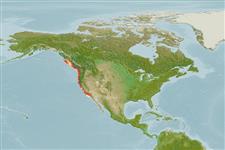Environment: milieu / climate zone / depth range / distribution range
Ökologie
seewasser demersal; tiefenbereich 84 - 368 m (Ref. 51666). Temperate; 55°N - 32°N
Eastern Pacific: British Columbia, Canada to San Diego in California, USA.
Size / Gewicht / Alter
Maturity: Lm ? range ? - ? cm
Max length : 13.0 cm TL Männchen/unbestimmt; (Ref. 2850)
Kurzbeschreibung
Bestimmungsschlüssel | Morphologie | Morphometrie
Rückenflossenstacheln (insgesamt) : 55 - 57; Rückenflossenweichstrahlen (insgesamt) : 0; Afterflossenstacheln: 2; Afterflossenweichstrahlen: 34 - 35. Caudal rounded; lower 6 rays of pectorals elongated (Ref. 6885). Dusky olive brown dorsally, paler below; about 25 vertical light bars, narrower than intervening spaces, about 3 vague dark blotches spaced along side imposed on other pattern; dorsal fin with oblique dark bars, some intensified to make black blotches, especially toward posterior end; caudal, anal and pectoral fins with dark bars parallel to edge leaving a pale margin; sometimes a dark spot on inner dorsal margin of caudal fin; pelvic fins without markings (Ref. 6885).
Inhabits gravel and sand bottom (Ref. 51666).
Life cycle and mating behavior
Geschlechtsreife | Fortpflanzung | Ablaichen | Eier | Fecundity | Larven
Eschmeyer, W.N., E.S. Herald and H. Hammann, 1983. A field guide to Pacific coast fishes of North America. Boston (MA, USA): Houghton Mifflin Company. xii+336 p. (Ref. 2850)
IUCN Rote Liste Status (Ref. 130435: Version 2024-2)
Bedrohung für Menschen
Harmless
Nutzung durch Menschen
Tools
Zusatzinformationen
Download XML
Internet Quellen
Estimates based on models
Preferred temperature (Ref.
123201): 6.3 - 8.8, mean 7.3 °C (based on 34 cells).
Phylogenetic diversity index (Ref.
82804): PD
50 = 1.0000 [Uniqueness, from 0.5 = low to 2.0 = high].
Bayesian length-weight: a=0.00389 (0.00180 - 0.00842), b=3.12 (2.94 - 3.30), in cm total length, based on all LWR estimates for this body shape (Ref.
93245).
Trophic level (Ref.
69278): 3.2 ±0.5 se; based on size and trophs of closest relatives
Fishing Vulnerability (Ref.
59153): Low vulnerability (10 of 100).
